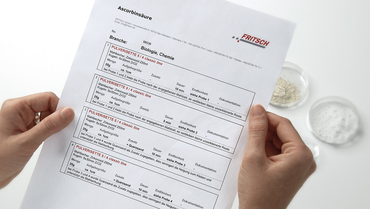Volver a vista general
Detection of azoic dye in clothing and fibre material
Of interest and as a first step, in search of forbidden aromatic amines made azoic dye, is therefore the determination of the type of fabric of the to be examined piece of clothing. For this, single fibres from the clothing, or like in the test, pieces of fabric of 3 x 3 mm may serve.
The verification, of what fibre it is, is obtained via infrared spectroscopy. For the instrument operating in transmission is the production of a preferably optic homogenous pellet made of potassium bromide necessary.
In the KBr-technology, the Mini-Mill PULVERISETTE 23 is for small pellets a widely used instrument. Due to the small sample amount, this mill was also chosen for these tests. According to experience, cloth is only to be comminuted with cutting powers. The mini mill almost only applies impact energy. In order to still finely comminute the fabric though, 20 mg of potassium bromide was added. After three minutes a homogenous powder was obtained. In a steel grinding set by exchanging the steel balls for a zirconium oxide ball the result was further improved. Apparently, the slight roughness of the surface of the special ceramic helps here.
Now, with the Mini-Mill, 250 mg potassium bromide was finely ground for 90 seconds. To this substance the prepared above mill feed was added and ground additionally 30 seconds and homogenised, then a pellet produced. Various tests aided in the optimisation.
Already the visual evaluation of the produced pellet showed the grinding success. With the measurement of the infrared spectroscopy the fibre was confirmed without a doubt as polyester.
-
Download the FRITSCH-report as PDF file
-
Detailed grinding reports
Volver a vista general








